Top-of-Atmosphere Shortwave Anisotropy over Liquid Clouds: Sensitivity to Clouds’ Microphysical Structure and Cloud-Topped Moisture
Abstract
:1. Introduction
2. Material and Methods
2.1. TOA SW Reflectances
2.1.1. CERES Edition 4 SSF
2.1.2. Broadband Radiative Transfer Simulations
2.2. Cloud-Topped Water Vapor
2.3. Angular Distribution Models
3. Results
4. Discussion
Author Contributions
Funding
Acknowledgments
Conflicts of Interest
References
- Ramanathan, V.; Cess, R.D.; Harrison, E.F.; Minnis, P.; Barkstrom, B.R.; Ahmad, E.; Hartmann, D. Cloud-Radiative Forcing and Climate: Results from the Earth Radiation Budget Experiment. Science 1989, 243, 57–63. [Google Scholar] [CrossRef] [PubMed]
- Wood, R. Stratocumulus Clouds. Mon. Weather Rev. 2012, 140, 2373–2423. [Google Scholar] [CrossRef]
- Bony, S.; Dufresne, J.L. Marine boundary layer clouds at the heart of tropical cloud feedback uncertainties in climate models. Geophys. Res. Lett. 2005, 32. [Google Scholar] [CrossRef] [Green Version]
- Nam, C.; Bony, S.; Dufresne, J.L.; Chepfer, H. The ‘too few, too bright’ tropical low-cloud problem in CMIP5 models. Geophys. Res. Lett. 2012, 39. [Google Scholar] [CrossRef] [Green Version]
- Twomey, S. The Influence of Pollution on the Shortwave Albedo of Clouds. J. Atmos. Sci. 1977, 34, 1149–1152. [Google Scholar] [CrossRef] [Green Version]
- Gryspeerdt, E.; Quaas, J.; Bellouin, N. Constraining the aerosol influence on cloud fraction. J. Geophys. Res. Atmos. 2016, 121, 3566–3583. [Google Scholar] [CrossRef] [Green Version]
- Costantino, L.; Bréon, F.M. Analysis of aerosol-cloud interaction from multi-sensor satellite observations. Geophys. Res. Lett. 2010, 37. [Google Scholar] [CrossRef] [Green Version]
- Painemal, D.; Kato, S.; Minnis, P. Boundary layer regulation in the southeast Atlantic cloud microphysics during the biomass burning season as seen by the A-train satellite constellation. J. Geophys. Res. Atmos. 2014, 119, 11288–11302. [Google Scholar] [CrossRef]
- Goren, T.; Rosenfeld, D. Satellite observations of ship emission induced transitions from broken to closed cell marine stratocumulus over large areas. J. Geophys. Res. Atmos. 2012, 117. [Google Scholar] [CrossRef] [Green Version]
- Christensen, M.W.; Stephens, G.L. Microphysical and macrophysical responses of marine stratocumulus polluted by underlying ships: Evidence of cloud deepening. J. Geophys. Res. Atmos. 2011, 116. [Google Scholar] [CrossRef] [Green Version]
- Toll, V.; Christensen, M.W.; Gassó, S.; Bellouin, N. Volcano and Ship Tracks Indicate Excessive Aerosol-Induced Cloud Water Increases in a Climate Model. Geophys. Res. Lett. 2017, 44, 12492–12500. [Google Scholar] [CrossRef] [PubMed]
- Ackerman, A.S.; Kirkpatrick, M.P.; Stevens, D.E.; Toon, O.B. The impact of humidity above stratiform clouds on indirect aerosol climate forcing. Nature 2004, 432, 1014–1017. [Google Scholar] [CrossRef] [PubMed] [Green Version]
- Viollier, M.; Standfuss, C.; Chomette, O.; Quesney, A. Top-of-Atmosphere Radiance-to-Flux Conversion in the SW Domain for the ScaRaB-3 Instrument on Megha-Tropiques. J. Atmos. Ocean. Technol. 2009, 26, 2161–2171. [Google Scholar] [CrossRef]
- Dewitte, S.; Gonzalez, L.; Clerbaux, N.; Ipe, A.; Bertrand, C.; Paepe, B.D. The Geostationary Earth Radiation Budget Edition 1 data processing algorithms. Adv. Space Res. 2008, 41, 1906–1913. [Google Scholar] [CrossRef]
- Su, W.; Corbett, J.; Eitzen, Z.; Liang, L. Next-generation angular distribution models for top-of-atmosphere radiative flux calculation from CERES instruments: Methodology. Atmos. Meas. Tech. 2015, 8, 611–632. [Google Scholar] [CrossRef]
- Wielicki, B.A.; Barkstrom, B.R.; Harrison, E.F.; Lee, R.B., III; Smith, G.L.; Cooper, J.E. Clouds and the Earth’s Radiant Energy System (CERES): An Earth Observing System Experiment. Bull. Am. Meteorol. Soc. 1996, 77, 853–868. [Google Scholar] [CrossRef]
- Minnis, P.; Sun-Mack, S.; Young, D.F.; Heck, P.W.; Garber, D.P.; Chen, Y.; Spangenberg, D.A.; Arduini, R.F.; Trepte, Q.Z.; Smith, W.L.; et al. CERES Edition-2 Cloud Property Retrievals Using TRMM VIRS and Terra and Aqua MODIS Data—Part I: Algorithms. IEEE Trans. Geosci. Remote Sens. 2011, 49, 4374–4400. [Google Scholar] [CrossRef]
- Barker, H.W.; Wiellicki, B.A.; Parker, L. A Parameterization for Computing Grid-Averaged Solar Fluxes for Inhomogeneous Marine Boundary Layer Clouds. Part II: Validation Using Satellite Data. J. Atmos. Sci. 1996, 53, 2304–2316. [Google Scholar] [CrossRef] [Green Version]
- Kato, S.; Rose, F.G.; Charlock, T.P. Computation of Domain-Averaged Irradiance Using Satellite-Derived Cloud Properties. J. Atmos. Ocean. Technol. 2005, 22, 146–164. [Google Scholar] [CrossRef] [Green Version]
- Hollstein, A.; Fischer, J. Radiative transfer solutions for coupled atmosphere ocean systems using the ma trix operator technique. J. Quant. Spectrosc. Radiat. Transf. 2012, 113, 536–548. [Google Scholar] [CrossRef]
- Doppler, L.; Preusker, R.; Bennartz, R.; Fischer, J. k-bin and k-IR: k-distribution methods without correlation approximation for n on-fixed instrument response function and extension to the thermal infrared—Application s to satellite remote sensing. J. Quant. Spectrosc. Radiat. Transf. 2014, 133, 382–395. [Google Scholar] [CrossRef]
- Rothman, L.; Gordon, I.; Barbe, A.; Benner, D.; Bernath, P.; Birk, M.; Boudon, V.; Brown, L.; Campargue, A.; Champion, J.P.; et al. The HITRAN 2008 molecular spectroscopic database. J. Quant. Spectrosc. Radiat. Transf. 2009, 110, 533–572. [Google Scholar] [CrossRef] [Green Version]
- Hansen, J.E. Multiple scattering of polarized light in a planetary atmosphere. part II: Sunlight reflected by terrestrial water clouds. J. Atmos. Sci. 1971, 28, 1400–1426. [Google Scholar] [CrossRef]
- McClatchey, R.A.; Fenn, R.W.; Selby, J.E.A.; Volz, F.E. Optical Properties of the Atmosphere; Technical Report AFCRL-71-0279; Air Force Cambridge Research Laboratories: Bedford, MA, USA, 1971. [Google Scholar]
- Brenguier, J.L.; Pawlowska, H.; Schüller, L.; Preusker, R.; Fischer, J.; Fouquart, Y. Radiative Properties of Boundary Layer Clouds: Droplet Effective Radius versus Number Concentration. J. Atmos. Sci. 2000, 57, 803–821. [Google Scholar] [CrossRef]
- Bloom, S.; da Silva, A.; Dee, D. Documentation and Validation of the Goddard Earth Observing System (GEOS) Data Assimilation System; Technical Report TM-2005-104606; NASA: Washington, DC, USA, 2005.
- Bolton, D. The Computation of Equivalent Potential Temperature. Mon. Weather Rev. 1980, 108, 1046–1053. [Google Scholar] [CrossRef] [Green Version]
- Cattani, E.; Costa, M.; Torricella, F.; Levizzani, V.; Silva, A. Influence of aerosol particles from biomass burning on cloud microphysical properties and radiative forcing. Atmos. Res. 2006, 82, 310–327. [Google Scholar] [CrossRef]
- Painemal, D.; Minnis, P.; Sun-Mack, S. The impact of horizontal heterogeneities, cloud fraction, and liquid water path on warm cloud effective radii from CERES-like Aqua MODIS retrievals. Atmos. Chem. Phys. 2013, 13, 9997–10003. [Google Scholar] [CrossRef] [Green Version]
- Doelling, D.R.; Loeb, N.G.; Keyes, D.F.; Nordeen, M.L.; Morstad, D.; Nguyen, C.; Wielicki, B.A.; Young, D.F.; Sun, M. Geostationary Enhanced Temporal Interpolation for CERES Flux Products. J. Atmos. Ocean. Technol. 2013, 30, 1072–1090. [Google Scholar] [CrossRef]
- Zhao, M.; Golaz, J.C.; Held, I.M.; Guo, H.; Balaji, V.; Benson, R.; Chen, J.H.; Chen, X.; Donner, L.J.; Dunne, J.P.; et al. The GFDL Global Atmosphere and Land Model AM4.0/LM4.0: 1. Simulation Characteristics With Prescribed SSTs. J. Adv. Model. Earth Syst. 2018, 10, 691–734. [Google Scholar] [CrossRef] [Green Version]
- Illingworth, A.J.; Barker, H.W.; Beljaars, A.; Chepfer, H.; Delanoe, J.; Domenech, C.; Donovan, D.P.; Fukuda, S.; Hirakata, M.; Hogan, R.J.; et al. The EarthCARE Satellite: The next step forward in global measurements of clouds, aerosols, precipitation and radiation. Bull. Am. Meteorol. Soc. 2015, 96, 1311–1332. [Google Scholar] [CrossRef]
- Diner, D.J.; Beckert, J.C.; Reilly, T.H.; Bruegge, C.J.; Conel, J.E.; Kahn, R.A.; Martonchik, J.V.; Ackerman, T.P.; Davies, R.; Gerstl, S.A.W.; et al. Multi-angle Imaging SpectroRadiometer (MISR) instrument description and experiment overview. IEEE Trans. Geosci. Remote Sens. 1998, 36, 1072–1087. [Google Scholar] [CrossRef]
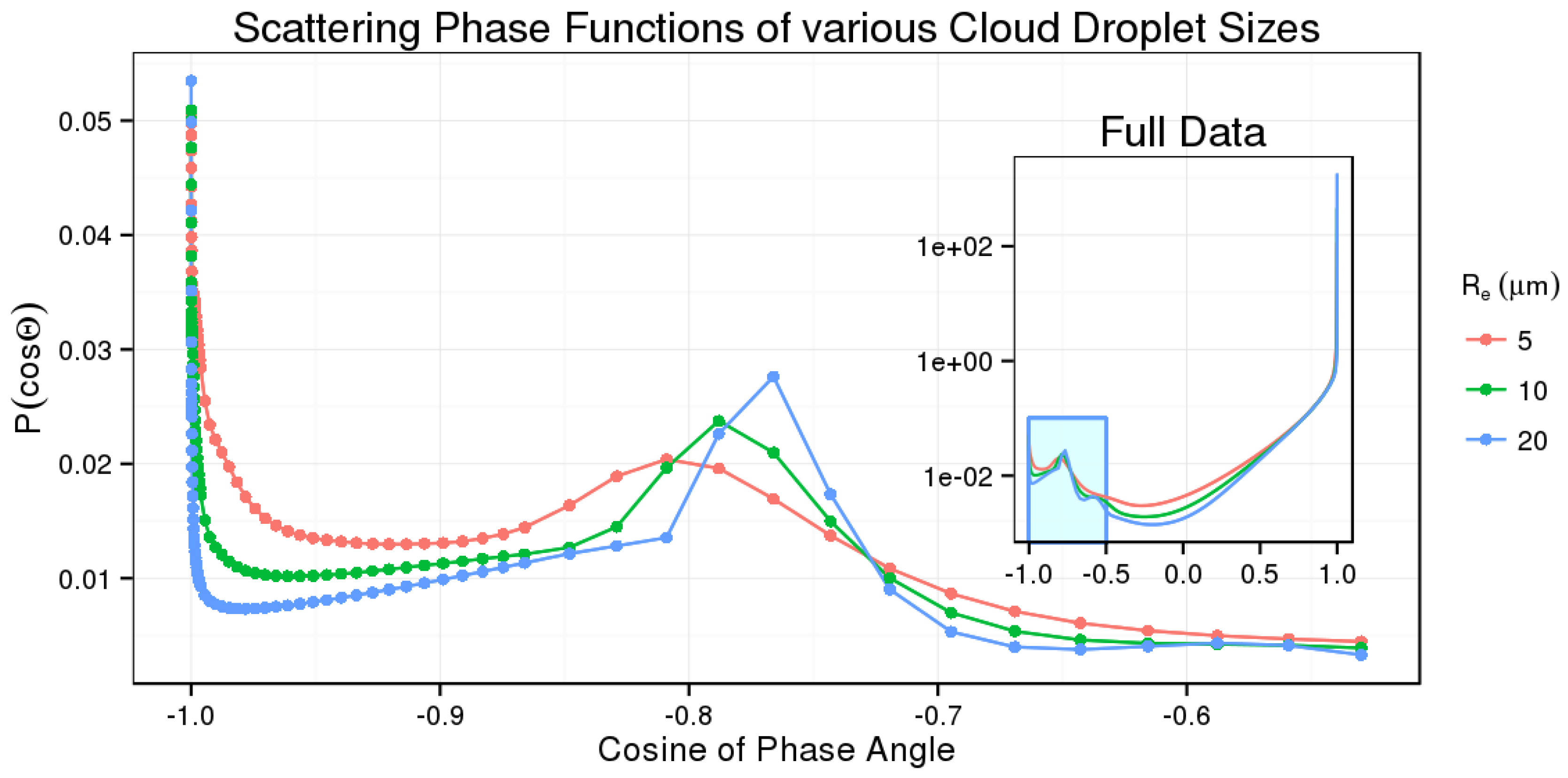
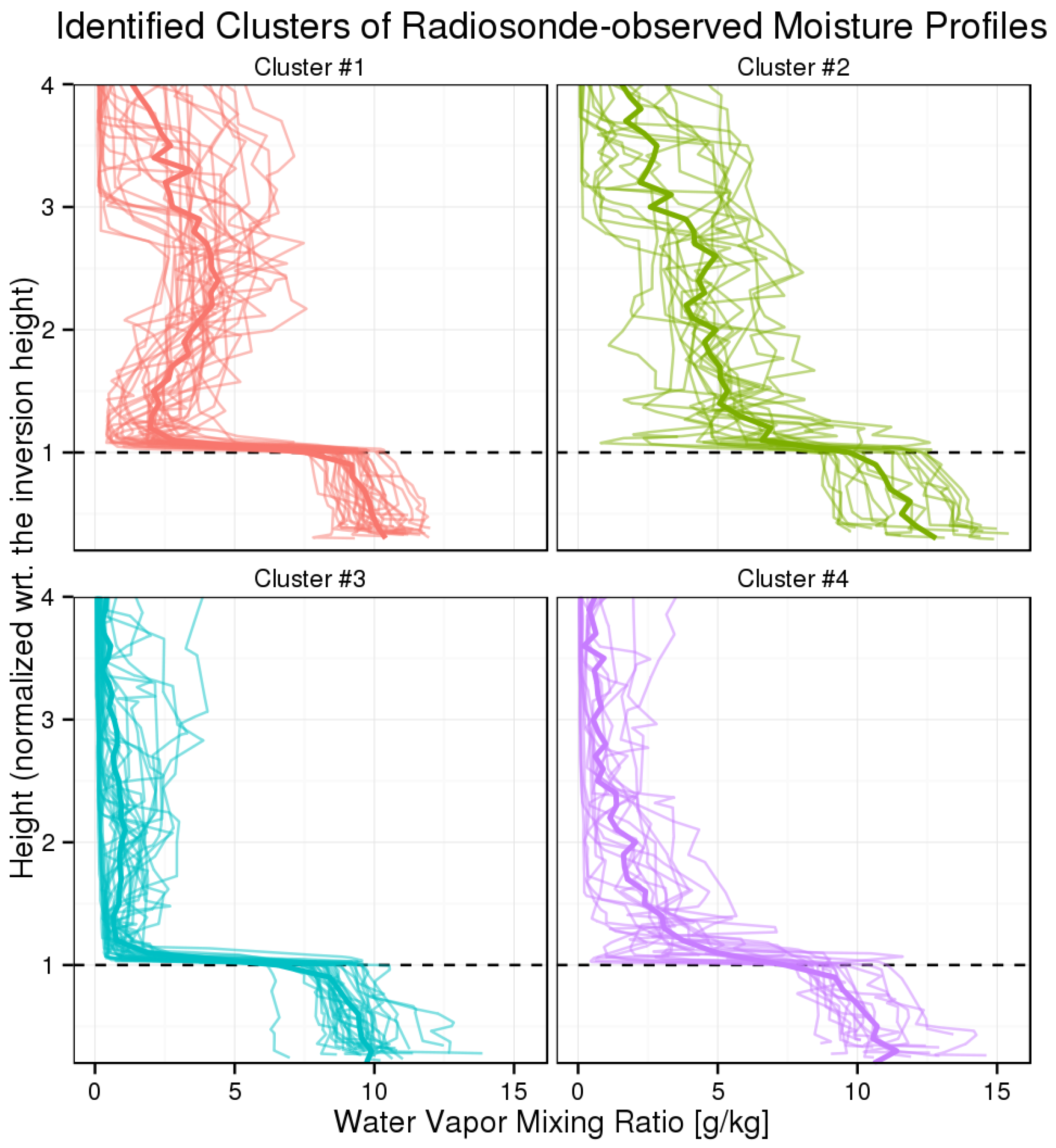
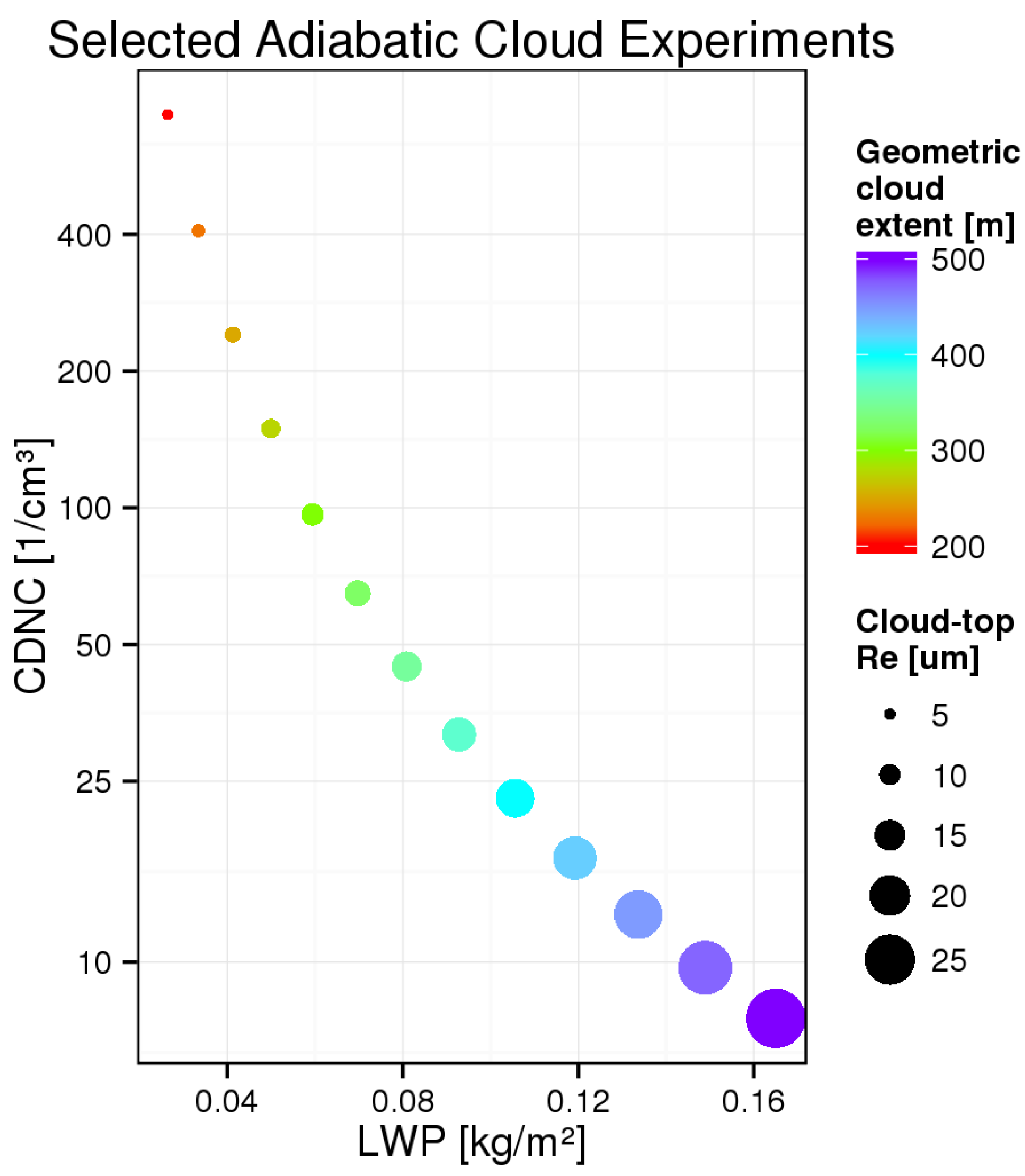

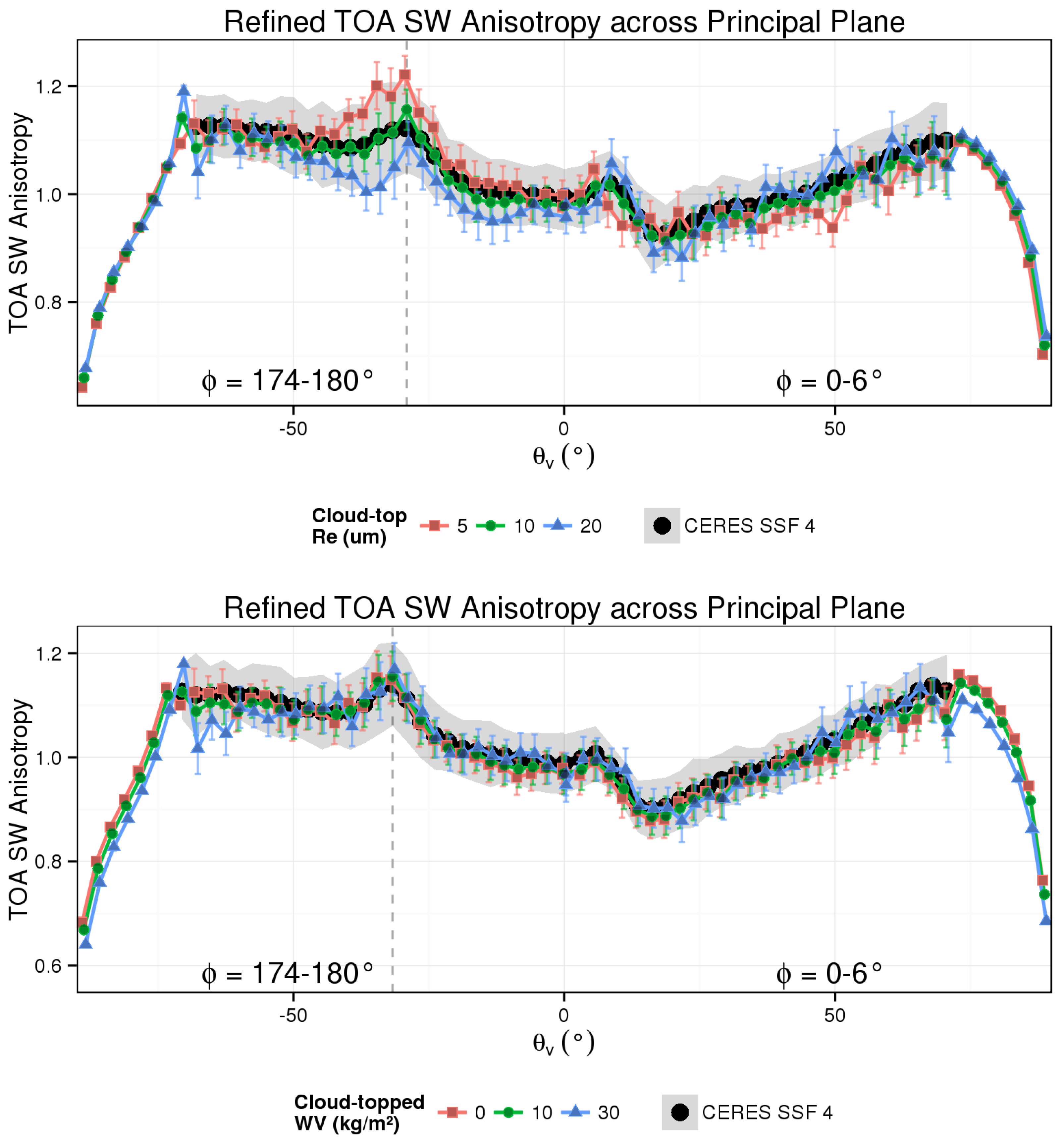
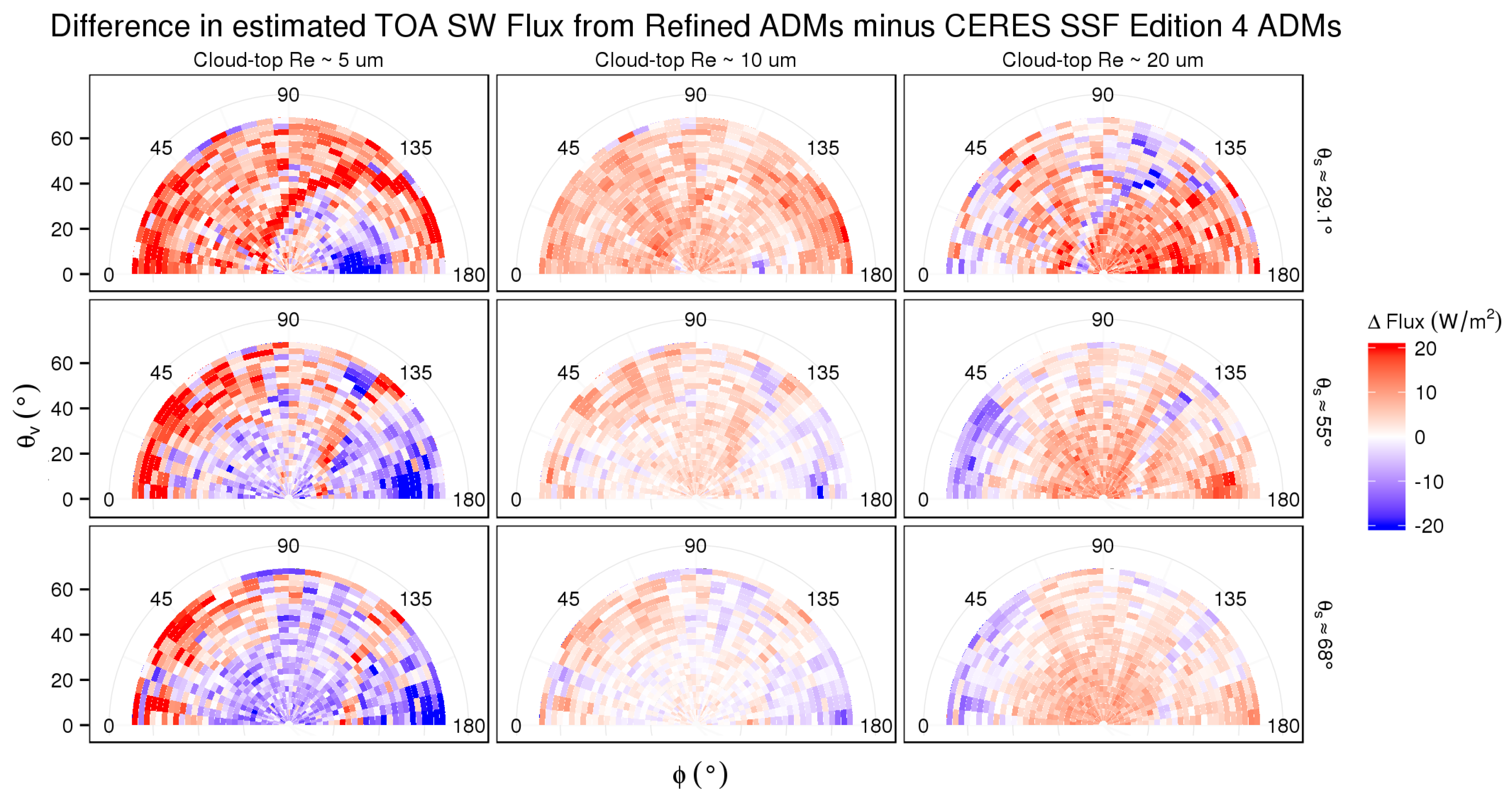

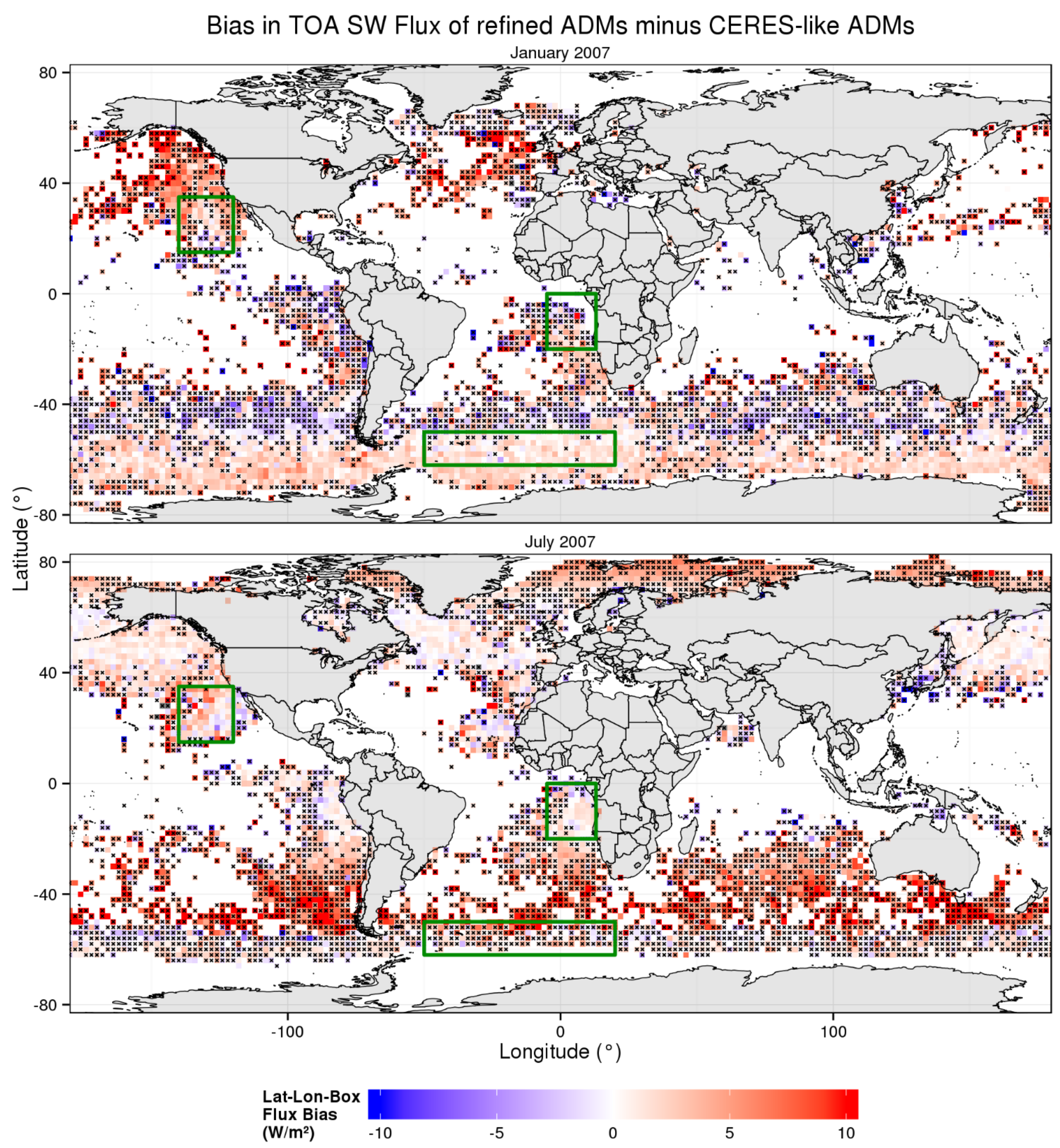
| No. of CERES Footprints | |||
|---|---|---|---|
| Year | Terra | Aqua | Mode |
| (FM1 and FM2) | (FM3 and FM4) | ||
| 2000 | 192,604 | / | RAPS |
| 2001 | 259,810 | / | RAPS |
| 2002 | 278,305 | 85,745 | RAPS |
| 2003 | 266,966 | 223,979 | RAPS |
| 2004 | 274,189 | 27,6981 | RAPS |
| 2005 | 4730 | 62,213 | RAPS |
| 2006 | / | / | / |
| 2007 | 273,343 | 271,234 | cross-track |
| CERES | Bins Supplemented | Min.–Max. in Angular Bin Medians of | ||
|---|---|---|---|---|
| () | Footprints | with Simulations (%) | Cloud-Top (m) | Cloud-Topped WV (kg m) |
| 16.2 | 16,144 | 33.3 | 5.9–26.2 | 0.0–30.8 |
| 18.8 | 29,636 | 14.4 | 6.8–17.6 | 0.0–27.2 |
| 21.4 | 42,413 | 7.1 | 6.8–14.8 | 0.0–20.7 |
| 23.9 | 53,459 | 2.6 | 7.7–14.0 | 0.0–16.7 |
| 26.5 | 70,327 | 1.5 | 9.1–16.5 | 0.0–15.6 |
| 29.1 | 84,465 | 1.0 | 9.1–15.3 | 0.0–16.3 |
| 31.7 | 92,215 | 0.8 | 8.8–15.5 | 0.0–14.3 |
| 34.3 | 103,819 | 0.6 | 8.6–13.3 | 0.0–13.3 |
| 36.9 | 110,576 | 0.3 | 9.5–13.9 | 0.9–12.0 |
| 39.5 | 111,249 | 0.3 | 9.3–14.1 | 0.4–12.7 |
| 42.1 | 113,933 | 0.2 | 10.1–14.1 | 0.0–12.3 |
| 44.7 | 110,230 | 0.2 | 10.4–14.1 | 0.2–8.6 |
| 47.3 | 108,844 | 0.8 | 10.7–15.4 | 1.0–8.7 |
| 49.9 | 103,208 | 0.2 | 10.9–15.1 | 0.0–9.2 |
| 52.4 | 97,595 | 0.6 | 11.1–17.3 | 0.3–7.9 |
| 55.0 | 85,986 | 0.8 | 9.5–16.1 | 0.0–8.9 |
| 57.6 | 75,292 | 1.3 | 11.0–15.4 | 0.0–9.2 |
| 60.2 | 67,078 | 1.0 | 10.7–16.5 | 0.0–7.8 |
| 62.8 | 58,011 | 1.8 | 11.5–18.0 | 0.0–10.5 |
| 65.4 | 45,071 | 2.4 | 7.9–17.5 | 0.0–10.3 |
| 68.0 | 55,063 | 2.1 | 12.2–20.1 | 0.0–7.4 |
| 70.6 | 43,824 | 2.6 | 10.0–19.6 | 0.0–7.7 |
| 73.2 | 37,792 | 4.0 | 11.7–21.9 | 0.0–12.0 |
| 75.8 | 30,961 | 6.7 | 8.9–19.7 | 0.0–18.0 |
| 78.3 | 22,864 | 14.1 | 10.8–22.5 | 0.0–16.6 |
| 80.9 | 16,282 | 25.5 | 9.2–22.5 | 0.0–16.6 |
| Median Anisotropy | Median Anisotropy | Median Ratio | |||
|---|---|---|---|---|---|
| Spread (%) | Uncertainties (%) | CERES/ | |||
| () | Cloud-Top | Cloud-Topped WV | Refined | CERES-Like | Refined |
| 16.2 | 3.9 | 2.0 | 3.2 | 6.0 | 1.7 |
| 18.8 | 3.9 | 1.9 | 3.7 | 5.9 | 1.5 |
| 21.4 | 3.5 | 1.6 | 4.0 | 6.1 | 1.5 |
| 23.9 | 3.2 | 1.5 | 4.0 | 6.0 | 1.5 |
| 26.5 | 2.9 | 1.3 | 4.0 | 5.7 | 1.4 |
| 29.1 | 2.9 | 1.3 | 4.1 | 5.7 | 1.4 |
| 31.7 | 3.1 | 1.3 | 4.2 | 5.7 | 1.4 |
| 34.3 | 3.2 | 1.3 | 4.3 | 5.6 | 1.3 |
| 36.9 | 3.3 | 1.5 | 4.4 | 5.5 | 1.2 |
| 39.5 | 3.3 | 1.3 | 4.5 | 5.3 | 1.2 |
| 42.1 | 3.3 | 1.5 | 4.5 | 5.3 | 1.2 |
| 44.7 | 2.9 | 1.5 | 4.4 | 5.4 | 1.2 |
| 47.3 | 3.6 | 1.6 | 4.2 | 5.3 | 1.2 |
| 49.9 | 3.7 | 1.5 | 4.0 | 5.2 | 1.3 |
| 52.4 | 3.2 | 1.7 | 4.0 | 5.2 | 1.3 |
| 55.0 | 3.8 | 1.8 | 3.9 | 5.2 | 1.3 |
| 57.6 | 4.5 | 2.0 | 3.7 | 5.1 | 1.4 |
| 60.2 | 4.7 | 1.9 | 3.6 | 5.0 | 1.4 |
| 62.8 | 5.0 | 2.1 | 3.4 | 4.9 | 1.4 |
| 65.4 | 5.6 | 2.7 | 3.4 | 4.9 | 1.4 |
| 68.0 | 5.4 | 2.6 | 3.4 | 4.8 | 1.4 |
| 70.6 | 6.2 | 2.9 | 3.4 | 4.7 | 1.4 |
| 73.2 | 6.7 | 3.4 | 3.3 | 4.6 | 1.3 |
| 75.8 | 6.8 | 3.7 | 3.4 | 4.7 | 1.3 |
| 78.3 | 7.0 | 4.3 | 3.4 | 4.8 | 1.4 |
| 80.9 | 8.0 | 6.4 | 5.3 | 6.4 | 1.2 |
| SE Atlantic | NE Pacific | Southern Ocean | ||||
|---|---|---|---|---|---|---|
| January | July | January | July | January | July | |
| No. of footprints | 602 | 2286 | 655 | 2376 | 4474 | 1004 |
| Solar Zenith Angle () | 26.6 (17.4–34.6) | 41.7 (34.2–49.8) | 54.8 (44.7–59.7) | 19.0 (10.4–27.9) | 44.0 (37.1–52.3) | 84.7 (75.7–86.2) |
| Cloud-top Effectie Radius ( ) | 11.0 (8.2–14.4) | 8.2 (6.6–14.4) | 11.6 (8.0–17.1) | 10.4 (7.6–16.0) | 10.5 (7.2–16.2) | 12.3 (8.8–16.7) |
| Cloud-topped Water Vapour (kg m) | 16.1 (5.5–29.0) | 1.6 (0.0–15.2) | 0.0 (0.0–8.3) | 11.6 (1.9–32.5) | 5.9 (2.2–14.1) | 0.5 (0.0-5.9) |
| TOA SW Flux Difference (W ) | 1.5 (−7.3–12.3) | 0.9 * (−6.4–7.9) | 2.4 (−3.3–9.9) | 0.7 * (−9.6–12.8) | 1.2 * (−6.0–7.7) | 1.1 (−3.0–10.9) |
© 2018 by the authors. Licensee MDPI, Basel, Switzerland. This article is an open access article distributed under the terms and conditions of the Creative Commons Attribution (CC BY) license (http://creativecommons.org/licenses/by/4.0/).
Share and Cite
Tornow, F.; Preusker, R.; Domenech, C.; Carbajal Henken, C.K.; Testorp, S.; Fischer, J. Top-of-Atmosphere Shortwave Anisotropy over Liquid Clouds: Sensitivity to Clouds’ Microphysical Structure and Cloud-Topped Moisture. Atmosphere 2018, 9, 256. https://doi.org/10.3390/atmos9070256
Tornow F, Preusker R, Domenech C, Carbajal Henken CK, Testorp S, Fischer J. Top-of-Atmosphere Shortwave Anisotropy over Liquid Clouds: Sensitivity to Clouds’ Microphysical Structure and Cloud-Topped Moisture. Atmosphere. 2018; 9(7):256. https://doi.org/10.3390/atmos9070256
Chicago/Turabian StyleTornow, Florian, René Preusker, Carlos Domenech, Cintia K. Carbajal Henken, Sören Testorp, and Jürgen Fischer. 2018. "Top-of-Atmosphere Shortwave Anisotropy over Liquid Clouds: Sensitivity to Clouds’ Microphysical Structure and Cloud-Topped Moisture" Atmosphere 9, no. 7: 256. https://doi.org/10.3390/atmos9070256




